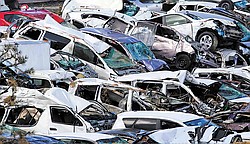Japan’s auto-parts factories struggle after March disaster
ASSOCIATED PRESS
In this photo taken Monday, April 4, 2011, new vehicles damaged by the March 11 tsunami are placed in a Toyota Motor Corp. parking lot at Sendai port, Miyagi prefecture, northern Japan. The imperative to resume normal output is pressing for small parts suppliers throughout northeast Japan, which must keep customers happy or face the prospect of losing major business to competitors at home and abroad.
Associated Press
ISHINOMAKI, Japan
In the days after Japan’s earthquake and tsunami, Masahiko Horio knew he had to get his factory back online quickly.
Customers were clamoring. The backlog of orders swelled.
The zinc and aluminum widgets made by his company, Horio Seisakusho Co., appear insignificant at first glance. But the tiny metal components represent a vital fraction of the thousands of parts used in a single car.
The global supply chain that feeds the giant automakers — Toyota, Honda and General Motors — begins at unassuming companies such as Horio Seisakusho. Japan’s recent disaster showed that one missing link can grind production lines around the world to a halt.
The imperative to resume normal output is pressing for small parts suppliers throughout northeast Japan, which must keep customers happy or face the prospect of losing major business to competitors at home and abroad. Already, companies in Taiwan and Southeast Asia are seeing orders climb as customers search for alternative supply sources.
The 54 employees at Horio Seisakusho in hard-hit Ishinomaki produce some 600 different electronic and auto parts, including basic components for car antennas and navigation systems. It managed to avoid tsunami damage because it sits on a hill. Nonetheless, the earthquake and power shortages idled its machines for two weeks.
Horio, the manufacturer’s president, faced another serious problem as he frantically worked to restart operations. An even smaller firm that finished and tested a half-dozen of his parts was wiped out by the March 11 tsunami. Horio couldn’t ship supplies to customers without this final step in quality control.
 43
43

